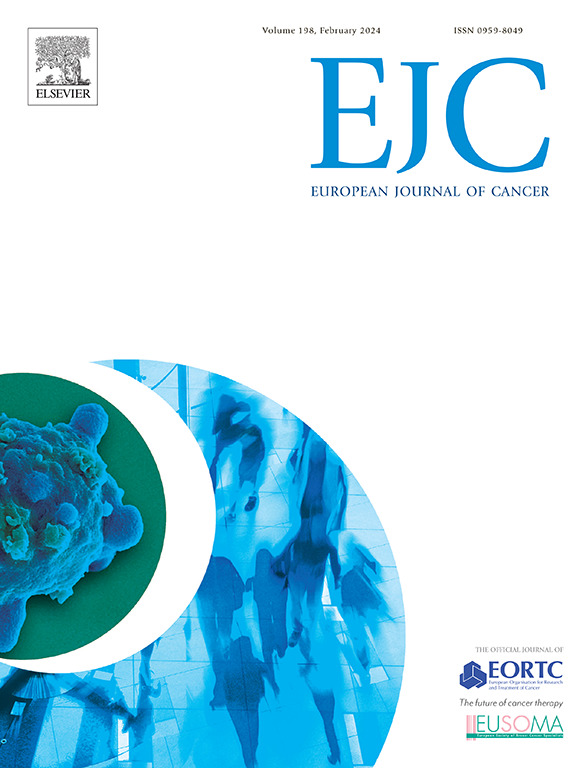Activity of lenvatinib-based therapy in previously treated patients with metastatic renal cell carcinoma: A European multicenter study (LENVA-LAT)
IF 7.6
1区 医学
Q1 ONCOLOGY
引用次数: 0
Abstract
Background and Objective
Lenvatinib’s activity after immune checkpoint inhibitors (ICI) combination therapy in renal cell carcinoma (RCC) remains unknown. We aimed to describe the real-world outcomes of patients with metastatic RCC (mRCC) treated with lenvatinib after failure of the prior standard of care.
Methods
Multicenter retrospective study including patients with mRCC treated with lenvatinib-based therapies beyond first-line therapy between 2020 and 2024. The primary endpoints were objective response rate (ORR) and time-to-treatment failure (TTF). Secondary endpoints included disease control rate (DCR), overall survival (OS), and safety.
Results
We included 133 patients, with a median age of 61 years. Clear-cell was the main subtype (82.0 %). Before lenvatinib treatment, 15.8 %, 51.9 %, and 27.8 % of patients showed favorable, intermediate, and poor risk disease, respectively, according to the International Metastatic RCC Database Consortium (IMDC). Moreover, patients received a median of 3 previous lines of treatment, including ICIs (90.2 %) and cabozantinib (90.2 %). Lenvatinib was given alone (45.9 %) or in combination with everolimus (33.8 %), pembrolizumab (18.0 %) or investigational agents (2.3 %). The ORR and DCR were 29.1 % and 67.7 %, respectively, with no differences between regimens or lines of treatment. With a median follow-up time of 13.5 months, the median TTF and OS were 6.2 and 9.6 months. Toxicity was manageable with dose modifications required in 34.6 %. The discontinuation rate was 9.8 %, with one toxic death.
Conclusion
Lenvatinib-based regimens were active and safe for heavily pre-treated patients with mRCC. These findings provide evidence to support its use in daily practice.
lenvatinib为基础治疗转移性肾癌患者的活性:一项欧洲多中心研究(LENVA-LAT)
背景与目的免疫检查点抑制剂(ICI)联合治疗肾细胞癌(RCC)后,envatinib的活性尚不清楚。我们的目的是描述在先前的标准治疗失败后,用lenvatinib治疗的转移性RCC (mRCC)患者的真实结果。方法采用多中心回顾性研究,纳入2020年至2024年一线治疗之外接受lenvatinib为基础治疗的mRCC患者。主要终点为客观缓解率(ORR)和治疗失败时间(TTF)。次要终点包括疾病控制率(DCR)、总生存期(OS)和安全性。结果纳入133例患者,中位年龄61岁。清细胞型为主要亚型(82.0 %)。根据国际转移性RCC数据库联盟(IMDC)的数据,lenvatinib治疗前,15.8% %、51.9% %和27.8% %的患者分别表现为有利、中等和低风险疾病。此外,患者接受了中位数为3个既往治疗线,包括ICIs(90.2 %)和cabozantinib(90.2 %)。Lenvatinib单独使用(45.9% %)或与依维莫司(33.8% %)、派姆单抗(18.0% %)或研究用药物(2.3 %)联合使用。ORR和DCR分别为29.1% %和67.7% %,不同治疗方案或治疗线之间无差异。中位随访时间为13.5个月,中位TTF和OS分别为6.2和9.6个月。34.6%( %)需要剂量调整,毒性是可控的。停药率为9.8% %,1例中毒性死亡。结论lenvatinib为基础的方案对重度预处理的mRCC患者有效且安全。这些发现为支持在日常实践中使用它提供了证据。
本文章由计算机程序翻译,如有差异,请以英文原文为准。
求助全文
约1分钟内获得全文
求助全文
来源期刊

European Journal of Cancer
医学-肿瘤学
CiteScore
11.50
自引率
4.80%
发文量
953
审稿时长
23 days
期刊介绍:
The European Journal of Cancer (EJC) serves as a comprehensive platform integrating preclinical, digital, translational, and clinical research across the spectrum of cancer. From epidemiology, carcinogenesis, and biology to groundbreaking innovations in cancer treatment and patient care, the journal covers a wide array of topics. We publish original research, reviews, previews, editorial comments, and correspondence, fostering dialogue and advancement in the fight against cancer. Join us in our mission to drive progress and improve outcomes in cancer research and patient care.
 求助内容:
求助内容: 应助结果提醒方式:
应助结果提醒方式:


